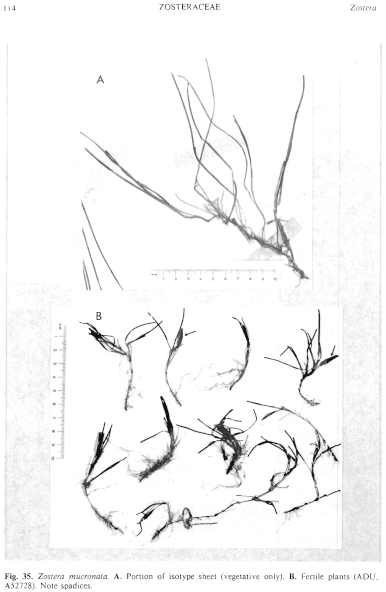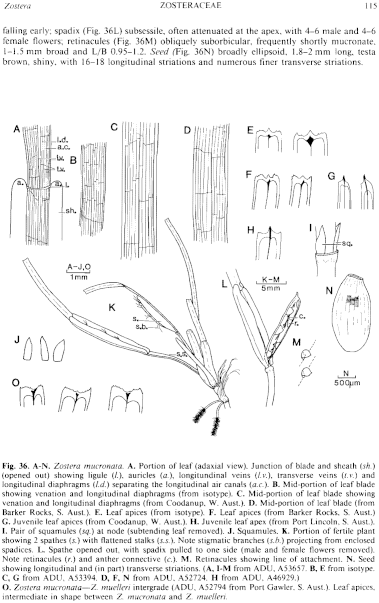|
|
|
|
|
|||||||||||
|
Electronic Flora of South Australia Species Fact Sheet
Phylum Magnoliophyta – Subphylum Seagrasses – Class Liliopsida – Subclass Alismatidae – Order Potamogetonales – Family Zosteraceae
Selected citations: Aston 1973: 330. fig. 137b. Green 1981: 5. Jessop 1978: 73.
Synonym
Zostera muelleri sensu Blackall & Grieve 1954: 8.
Perennial (Fig. 35B) with much-branched rhizomes. Rhizomes 1–2 mm in diameter, internodes 0.5–1.5 (–4) cm long. Roots (1–) 2 (–4) per node. Vegetative shoots more or less prostrate with a cluster of leaves at the apex. Leaves (Fig. 36A–H) 2–5 per shoot; sheath (Fig. 36A) 0.6–1.5 (–5) cm long with margins overlapping, ligule very short, about 0.1 (–0.2) mm long, auricles about 0.5 mm long; blade (Fig. 36A–D) linear, usually about 5 cm long (up to 20 cm long when plants permanently submerged), (0.5–) 1.5–2 (–2.5) mm broad with 3 longitudinal veins, the lateral ones submarginal, joining the midvein, transverse veins somewhat irregular, rarely extending unbroken from the midvein to the submarginal vein; apex (Fig. 36E–H) tridentate with the central tooth a prolongation of the central vein and always prominent in juvenile leaves, with the two lateral teeth sometimes somewhat rounded, occasional fine denticulations sometimes present. Squamules (Fig. 361,J) lanceolate. Fertile shoots (Fig. 36K) short, 0.5–1.5 cm long, bearing 1 to a few spadices (i.e. one at each of several successive nodes), spathe 1–2 cm long on a flattened stalk (0.5–) 1–3 cm long, spathal blade frequently falling early; spadix (Fig. 36L) subsessile, often attenuated at the apex, with 4–6 male and 4–6 female flowers; retinacules (Fig. 36M) obliquely suborbicular, frequently shortly mucronate, 1–1.5 mm broad and L/B 0.95–1.2. Seed (Fig. 36N) broadly ellipsoid, 1.8–2 mm long, testa brown, shiny, with 16–18 longitudinal striations and numerous finer transverse striations.
Type from Mandurah, W. Aust., in sandy estuary (G.G. Smith 274, 16.viii.1950); in L, isotype in PERTH.
Selected specimens: Mandurah, W. Aust., in sandy estuary (G. G. Smith 274, 16.viii.1950; isotype PERTH). Coodanup Beach, Peel Inlet, W. Aust., 0.5 m deep (Carstairs, 12.ix.1982; ADU, A53394). Tulka, Port Lincoln, S. Aust., mid eulittoral (Womersley, 6.i.1976; ADU, A46929). Barker Rocks, Yorke Peninsula, S. Aust., mid eulittoral flats (Robertson, 15.xi.1981; ADU, A52724). Goldsmith Beach (near Edithburgh), S. Aust., upper sublittoral (Robertson, 14.xi.1981; ADU, A52728). Sultana Point, Edithburgh, S. Aust., intertidal (Owen, 23.xii.1969; ADU, A35723). Port Clinton, S. Aust., mid eulittoral (Robertson, 2.x.1982; ADU, A53657). Muston, American River Inlet, Kangaroo I., S. Aust., 0–0.5 m deep (O'Hazy, 13.iv.1982; ADU, A53008).
Distribution: From the Swan River estuary, W. Aust., southwards and eastwards to Spencer Gulf and Gulf St Vincent as far as Port Clinton, S. Aust., in estuaries and on sheltered intertidal sand and mud flats, some plants permanently submerged. Ruppia tuberosa and Lepilaena marina are frequently found growing in association with Z. mucronata on sheltered intertidal flats around the South Australian coastline, e.g. at Port Clinton, S. Aust. (P1. 16 fig. 5).
Taxonomic notes: When den Hartog (1970, p. 91) described Z. mucronata only sterile material was known (see isotype photo, Fig. 35A). Fertile material which compares well with the type is now available. However, although Z. mucronata sensu stricto is well-defined, many populations in South Australia and Victoria are now known with some leaves bearing a more or less well-developed central mucro and other leaves notched [e.g. Port Gawler, S. Aust., mid eulittoral (Robertson, 16.xii.1981; ADU, A52794) (see Fig. 360)]. It is not always possible to distinguish between Z. mucronata and Z. muelleri with these intergrades. (See further discussion under Z. muelleri.)
References:
ASTON, H. (1973). Aquatic plants of Australia. (Melbourne University Press: Melbourne.)
BLACKALL, W.E. & GRIEVE, B.J. (1954). How to know Western Australian Wildflowers. Part I. (University of Western Australia Press: Perth.)
DEN HARTOG, C. (1970). The seagrasses of the World. Verh. k. ned. Akad. Wet. Afd. Natuurk., ser. 2, 59(1), 1–275 (-1–31 Plates).
GREEN, J.W. (1981). Census of the Vascular Plants of Western Australia. (Western Australian Herbarium: South Perth.)
JESSOP, J.P. (1978). J.M. Black's Flora of South Australia. 3rd edn. Part I. (Govt. Printer: Adelaide.)
The Marine Benthic Flora of Southern Australia Part I complete list of references.
Publication:
Womersley, H.B.S. (31 May, 1984)
The Marine Benthic Flora of Southern Australia
Part I
©Board of the Botanic Gardens and State Herbarium, Government of South Australia
Illustrations in Womersley Part I, 1984: PLATE 16 fig. 5; FIGS 35, 36.

Plate 16 enlarge
PLATE 16 Fig. 1. Posidonia sp. (probably P. angustifolia) and Amphibolis antarctica. Off Seacliff, Adelaide, S. Aust., 5 m deep. (Photo by J.E. Johnson.)
Fig. 2. Posidonia balls (close up). Middleton beach, near Port Elliot, S. Aust. (Photo by E.M. Wollaston.)
Fig. 3. Posidonia balls. Middleton beach, near Port Elliot, S. Aust. (Photo by E.M. Wollaston.)
Fig. 4. Heterozostera tasmanica and Halophila australis community. Carcase Rock, off Eyre Peninsula, S. Aust., 6 m deep; (34°44'S, 136°05'E.). (Photo by S.A. Shepherd.)
Fig. 5. Zostera mucronata with Lepilaena marina and Ruppia tuberosa in foreground, and mangrove seedlings in the background. Mid eulittoral tidal flats, Port Clinton, S. Aust. (Photo by E.L. Robertson.)

Figure 35 enlarge
Fig. 35. Zostera mucronata. A. Portion of isotype sheet (vegetative only). B. Fertile plants (ADU, A52728). Note spadices.

Figure 36 enlarge
Fig. 36. A–N. Zostera mucronata. A. Portion of leaf (adaxial view). Junction of blade and sheath (sh.) (opened out) showing ligule (l.), auricles (a.), longitundinal veins (1.v.), transverse veins (t.v.) and longitudinal diaphragms (l.d.) separating the longitudinal air canals (a.c.). B. Mid-portion of leaf blade showing venation and longitudinal diaphragms (from isotype). C. Mid-portion of leaf blade showing venation and longitudinal diaphragms (from Coodanup, W. Aust.). D. Mid-portion of leaf blade (from Barker Rocks, S. Aust.). E. Leaf apices (from isotype). F. Leaf apices (from Barker Rocks, S. Aust.) G. Juvenile leaf apices (from Coodanup, W. Aust.). H. Juvenile leaf apex (from Port Lincoln, S. Aust.). I. Pair of squamules (sq.) at node (subtending leaf removed). J. Squamules. K. Portion of fertile plant showing 2 spathes (s.) with flattened stalks (s.s.). Note stigmatic branches (s.b.) projecting from enclosed spadices. L. Spathe opened out, with spadix pulled to one side (male and female flowers removed). Note retinacules (r.) and anther connective (c.). M. Retinacules showing line of attachment. N. Seed showing longitudinal and (in part) transverse striations. (A, I–M from ADU, A53657. B, E from isotype. C, G from ADU, A53394. D, F, N from ADU, A52724. H from ADU, A46929.)
O. Zostera mucronata-Z. muelleri intergrade (ADU, A52794 from Port Gawler, S. Aust.). Leaf apices, intermediate in shape between Z. mucronata and Z. muelleri.

|
Email Contact: State Herbarium of South Australia |

|